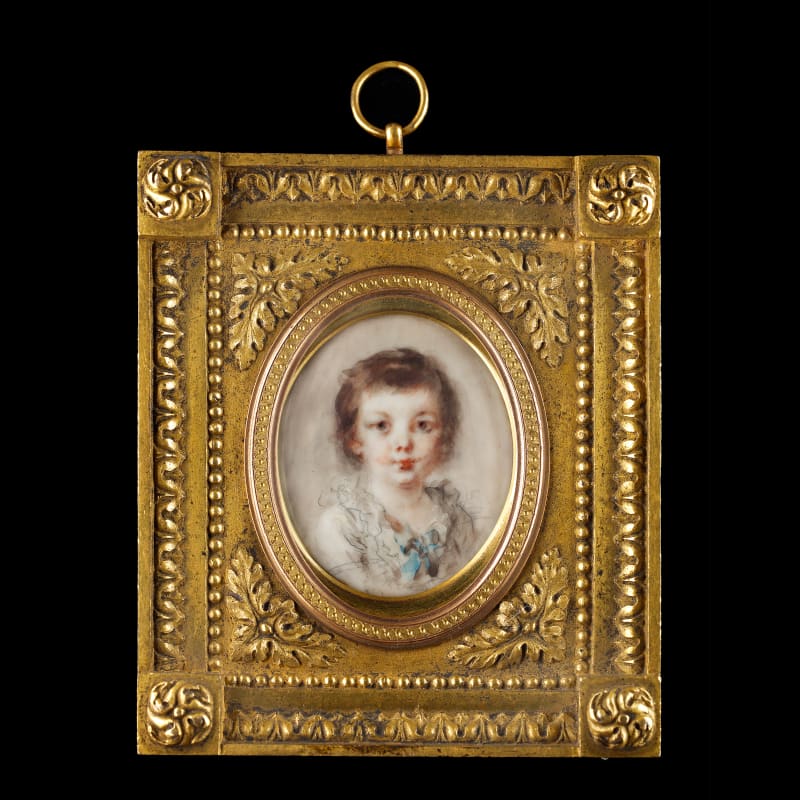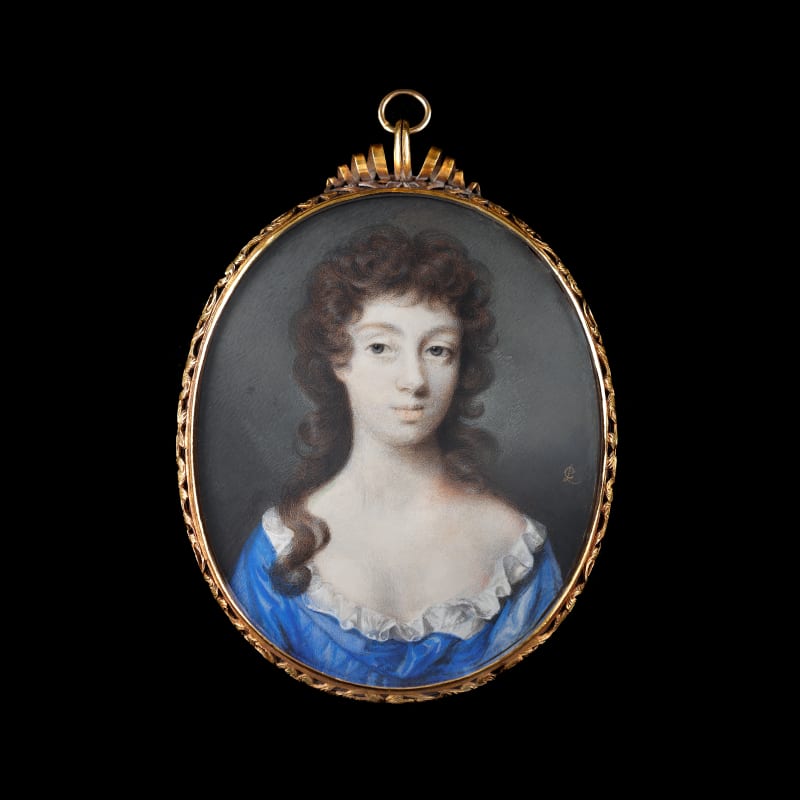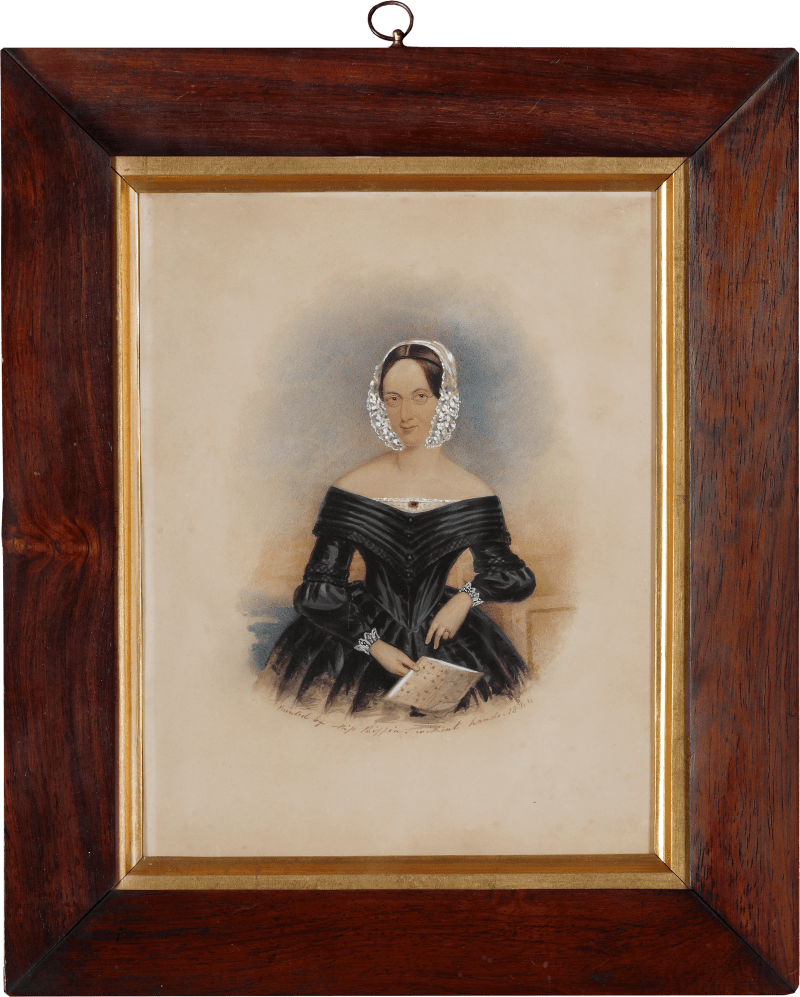
Diana Hill
(1760-1844) A Gentleman, wearing blue coat with braided buttons, white waistcoat and frilled shirt with stock, his hair powdered and worn en queueProvenance
Private Collection, UK.
This striking portrait dates to the artist’s first years in India, where Hill arrived in 1786. For almost a decade Hill exhibited at the Royal Academy, changing her surname from the original Dietz after her marriage to Haydock Hill in 1781. The marriage was short-lived, as Diana’s husband died at the age of thirty-five in September 1785.
As a widow with two young children, Hill decided to seek work in India, following closely in the footsteps of John Smart (1741-1811) who had left for Madras the previous year. To travel so far unaccompanied, to a country perceived as dangerous with its inhospitable climate, rampant with disease, reveals something of Hill’s ambition and tenacity. However, it was a shrewd career move - her connections with the East India Company through her brother in law, John Hill, proved vital in securing commissions. One of her first sittings came from William Larkins, accountant-general and a central figure in Calcutta high society.
...This striking portrait dates to the artist’s first years in India, where Hill arrived in 1786. For almost a decade Hill exhibited at the Royal Academy, changing her surname from the original Dietz after her marriage to Haydock Hill in 1781. The marriage was short-lived, as Diana’s husband died at the age of thirty-five in September 1785.
As a widow with two young children, Hill decided to seek work in India, following closely in the footsteps of John Smart (1741-1811) who had left for Madras the previous year. To travel so far unaccompanied, to a country perceived as dangerous with its inhospitable climate, rampant with disease, reveals something of Hill’s ambition and tenacity. However, it was a shrewd career move - her connections with the East India Company through her brother in law, John Hill, proved vital in securing commissions. One of her first sittings came from William Larkins, accountant-general and a central figure in Calcutta high society.
Further important commissions followed, including a portrait miniature of Charles Cornwallis, 1st Marquess Cornwallis, in 1786.[1] Cornwallis had been appointed in February 1786 to serve as both Commander-in-Chief of British India and Governor of the Presidency of Fort William, also known as the Bengal Presidency. A sitting from such a prominent member of the expatriate community would have garnered many more commissions from his lower ranking officials, including the present portrait.
Two years later, Hill’s continuing progress was noted by the painter Thomas Daniell, who in November 1788 wrote to Humphry, who had returned to England: 'Mrs. Hill is still making handsome faces, in the house you lived in last in Calcutta'.[2]
For the most part, Hill’s career followed closely that of her male peers. She was trained by Jeremiah Meyer, who held a position at court as official painter to George III. From 1777 she regularly exhibited at the Royal Academy from Angel Court in Windmill Street, and from these records a distinctly female following emerges. Her move to India in the mid-1780s coincided with other (male) artists similarly seeking the patronage of those in the employ of the East India Company, including Johan Zoffany, John Smart and Ozias Humphry. Where her career differed was in the breaks which corresponded with her two marriages, as well as in the demographic and subject matter she painted. The jealousy she aroused in the miniaturist Ozias Humphry indicates the advantage he felt she had as a rare female artist in a landscape dominated by men, firstly describing her as a ‘pretty young widow with two young children’ and secondly declaring : he would 'rather have had all the male painters in England landed in Bengal than a single woman'. Although she exhibited a handful of works after her first marriage in 1785, the subjects were flower pictures. After her second marriage in 1788, she gave up painting professionally, although a portrait of her husband exists dated 1791.[3]
Hill’s lasting influence as a pioneering female artist can be found in her children and grandchildren. Of her two sons from her second marriage with Thomas Harriott, William Henry Harriott (d. 1839) became a clerk in the War Office, a watercolour painter, and a friend of Cotman. Hill’s granddaughter, christened Sibella Christina, also became an artist.
Ivory Act:
This artwork has been registered by Philip Mould and Company as qualifying as exempt from the ivory act. Please contact laura@philipmould.com if you have any further queries.
Ivory Registration: HQ2T5YHX
[1] Now at Mount Vernon, Gift of Katherine Merle-Smith Thomas, 2010, H-4912
[2] W. Foster, ‘British artists in India, 1760–1820’, Walpole Society, 19 (1930–31), 1–88, p. 40
[3] A portrait of Lieutenant Thomas Harriott, the artist's second husband, is now in the Victoria and Albert Museum
P.126-1920









